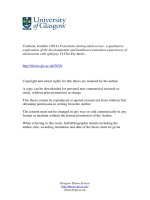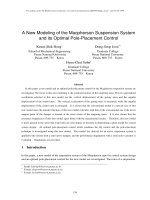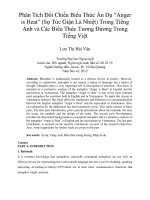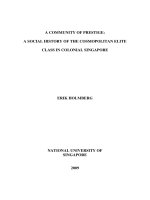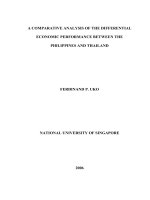36400 blackbeard a true pirate of the caribbean
Bạn đang xem bản rút gọn của tài liệu. Xem và tải ngay bản đầy đủ của tài liệu tại đây (100.66 KB, 4 trang )
I.- READ BOTH TEXTS ABOUT BLACKBEARD AND DECIDE WHICH
ONE IS TRUE
Edward Teach, (1680 – 22 November 1718) commonly referred to as
Blackbeard, was a notorious pirate and nemesis to most of the other famous
pirates of the time. He is one element from the novel On Stranger Tides by Tim
Powers. Blackbeard was the heartless pirate captain of the Queen Anne's
Revenge and a master of black arts, who wanted to find the Fountain of Youth
to escape a prophecy of his death by a one-legged man. Blackbeard's prophetic
murderer is later revealed to be another pirate, Robert Maynard, who
amputated his leg to escape Blackbeard's attack on the Adventure, which
Blackbeard then shrunk and placed in a bottle with countless other ships.
Blackbeard threatened most of his staff of officers to follow his every order. He
was said to be "the one pirate all pirates fear", Blackbeard practiced voodoo,
which he probably learnt during his rampaging years and apparently that cost
him to be alienated from the rest of the pirates.
In 1750, the story about his death at the battle of Ocracoke Inlet in 1718
still circles the Caribbean. As stated by Alexander Spotswood, great pirate,
people believe that Blackbeard was beheaded, and that his headless body
swam three times around his ship before climbing back on board.
Eventually, according to tales and letters from Alexander Spotswood to
allies and spies in the Governor of Virginia’s office, Maynard cornered
Blackbeard on a little island and shot him dead and burnt the corpse so he
wouldn’t come back from the death again. To ensure his reward for killing the
pirate, Maynard took Blackbeard’s sword and used it to cut his nose and
moustache.
Edward Teach (1680 – 22 November 1718), better known as
Blackbeard, was a notorious English pirate who operated around the West
Indies and the eastern coast of the American colonies. Although little is known
about his early life, he was likely born in Bristol, England. He may have been a
sailor on privateer ships during Queen Anne's War before settling on the
Caribbean island of New Providence, a base for Captain Benjamin Hornigold,
whose crew Teach joined sometime around 1716. Hornigold placed him in
command of a sloop he had captured, and the two engaged in numerous acts
of piracy. Their numbers were boosted by the addition to their fleet of two more
ships, one of which was commanded by Stede Bonnet.
Teach captured a French merchant vessel, renamed her Queen Anne's
Revenge, and equipped her with 40 guns. He became a renowned pirate, his
cognomen derived from his thick black beard and fearsome appearance; he
was reported to have tied lit fuses under his hat to frighten his enemies. He
formed an alliance of pirates and blockaded the port of Charleston, South
Carolina. After successfully ransoming its inhabitants, he ran Queen Anne's
Revenge aground on a sandbar near Beaufort, North Carolina. He parted
company with Bonnet, settling in Bath Town, where he accepted a royal pardon.
But he was soon back at sea and attracted the attention of Alexander
Spotswood, the Governor of Virginia. Spotswood arranged for a party of soldiers
and sailors to try to capture the pirate, which they did on 22 November 1718.
During a ferocious battle, Teach and several of his crew were killed by a small
force of sailors led by Lieutenant Robert Maynard.
A shrewd and calculating leader, Teach spurned the use of force, relying
instead on his fearsome image to elicit the response he desired from those he
robbed. Contrary to the modern-day picture of the traditional tyrannical pirate,
he commanded his vessels with the permission of their crews and there is no
known account of his ever having harmed or murdered those he held captive.
He was romanticised after his death and became the inspiration for a number
of pirate-themed works of fiction across a range of genres.
II.- Now, write 6 important TRUE facts about Blackbeard. Write 3 in active
voice and 3 in passive voice.
a)
b)
c)
d)
e)
f)
III.- Write FALSE sentences that are opposite to the ones you wrote
before. Then, rewrite both in reported speech
a)
b)
c)
d)
e)
f)
NOTES FOR TEACHERS:
Give the 2 different paragraphs to your students and let them read
carefully. The first text is loosely based on the “Disney’s Pirates of the
Caribbean: On Stranger Tides” film; the second text has the real facts in
a short version. Have them try to guess which one is true and which is
not and try to explain why they decided that. After that, reveal which is
the correct one.
In the second exercise, students must look for 6 facts about
Blackbeard that they find interesting, but they must be true facts, and
write half of them in active voice and the other half in passive. Then they
write false sentences which are somehow opposite to the ones that are
true, or that they contradict them; again, 3 in active and 3 in passive
voice.
As a final exercise, they must rewrite the “pairs” of sentences in
reported speech.



